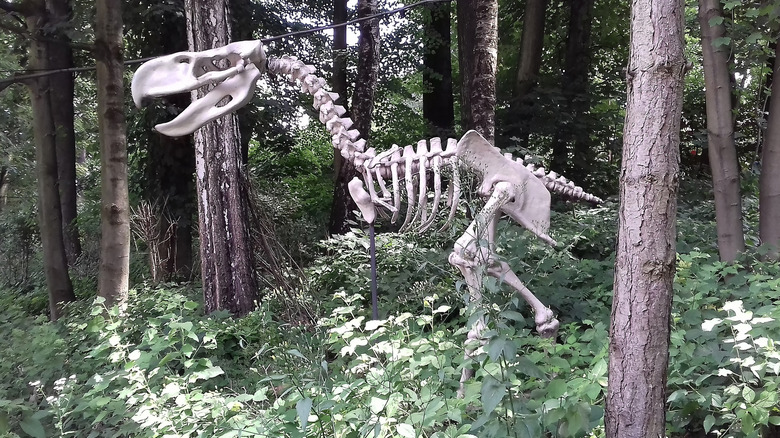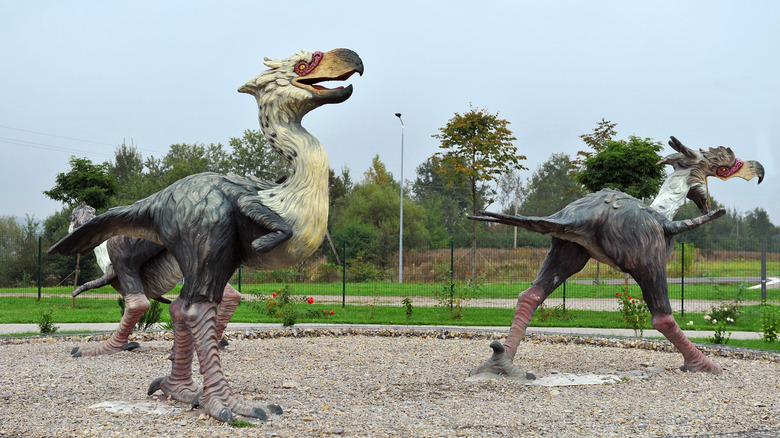The Bird Taller Than A Basketball Player That's Pure Nightmare Fuel
The fossil record is a treasure trove of prehistoric giants that could make even the most fearless modern-day human pause — just take a look at these 12 prehistoric sea animals or this fossilized spider from Australia if you need proof. But among the ranks of ancient terrifying giants and creepy crawlies, birds rarely come to mind. That outlook deserves to change, however, as researchers have discovered the fossilized remains of a species of "terror bird" that once roamed South America.
In a recent study published in Papers in Palaeontology, scientists detail a colossal bird that could be a new species belonging to the Phorusrhacidae, a group of apex predators that thrived during the Miocene epoch. Standing over 8 feet tall and weighing up to 344 pounds, the animal might be the largest terror bird ever discovered.
The fossils, unearthed in Colombia's La Venta site, are the first of their kind discovered so far north on the South American continent, indicating that these kinds of birds were able to adapt to a wide range of environments. The finding also plays a role in discovering how the birds evolved as they moved into North America, essentially conquering the ecological landscape in the process.
A terror bird worthy of its name
Evidence for this potentially new type of terror bird comes from a fossilized leg bone at La Venta, and despite representing a small part of the animal's total skeleton, scientists can piece together a significant amount of information about the bird. The carnivorous creature was in many ways similar to others in the Phorusrhacidae family, featuring a massive beak and skull adaptations suggesting they were highly efficient predators.
Much like other members of this family, the terror bird was cursorial, meaning it was adapted to running. And though some smaller species had limited flying abilities, terror birds' large legs meant that some species could reach speeds of 60 mph. At over 340 pounds, this new find would also put it in the heavyweight division among its peers, as terror bird species tend to weigh between 11 and 220 pounds.
The presence of unique bone protrusions in the fossil has led scientists to suspect it could be a completely new species. But the lack of comparable body parts in the fossil record of other terror bird species means that definitively announcing the La Venta find as a completely new type of terror bird is, for the moment at least, untenable.
Putting the evolutionary picture together
The find of the fossilized terror bird in Colombia's La Venta site has added a critical piece to the puzzle of these apex predators' evolutionary journey northward from South America, as it marks the northernmost discovery of a Phorusrhacidae member on the continent.
"Until the recovery of this animal, we had a huge geographical gap between Argentina and Brazil, where other terror birds are known, and in the States," lead study author Federico Javier Degrange, a researcher at the National University of Córdoba in Argentina, told CNN. "It tells us that, for terror birds, some species lived in more tropical environments."
Because most terror bird fossils are found in South America, scientists believe this is where they originated, slowly moving north during the Great American Biotic Interchange, a period of time when land and freshwater fauna moved between the North and South American continents via a land bridge in what is now Panama. By studying this fossil and others like it, researchers hope to uncover more about how terror birds' size, speed, and versatility enabled them to dominate the food chain across two continents.
Such species migration can have significant impacts on local ecosystems. If you're interested in learning about what this looks like in the modern day, check out the invasive species that's destroying the Florida Everglades.


